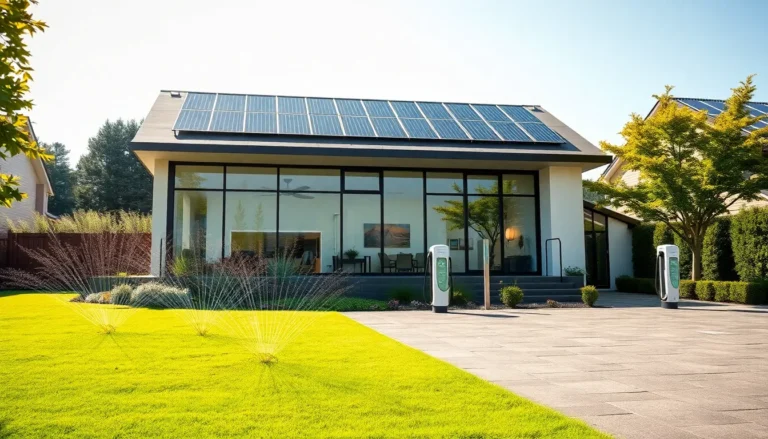When it comes to pests, most people would rather deal with a surprise visit from their in-laws than share their home with unwelcome critters. Whether it’s ants marching in formation or cockroaches throwing late-night dance parties, these uninvited guests can turn a cozy home into a scene straight out of a horror movie. But fear not! Effective pest treatment is here to save the day and restore peace in your living space.
Table of Contents
ToggleOverview of Effective Pest Treatment
Effective pest treatment focuses on eliminating unwanted pests and maintaining a peaceful living environment. Understanding pests and employing the right strategies makes a significant difference.
Importance of Pest Control
Pest control plays a vital role in ensuring health and safety. Uncontrolled infestations can lead to health risks, including allergies and disease transmission. Protecting homes from pests, such as rodents and insects, prevents property damage. Implementing pest management solutions can save money in repairs and reduce stress for homeowners. Regular pest control practices create a safer and more enjoyable space for families.
Common Pest Types
Many household pests create challenges for homeowners. Ants, for example, invade kitchens in search of food. Cockroaches pose a risk due to their ability to spread diseases. Rodents, including mice and rats, are known to contaminate food and damage structures. Termites can silently destroy wooden frameworks, leading to costly repairs. Bed bugs cause discomfort through their bites, affecting sleep quality. Understanding these common pests enables individuals to seek effective treatment options promptly.
Methods of Pest Treatment

Various methods exist for effective pest treatment, catering to different types of infestations and homeowner preferences. Understanding these options helps ensure the right approach for a pest problem.
Chemical Treatments
Chemical treatments involve the use of pesticides to eliminate pests. Many products are available, including sprays, baits, and granules. Each product targets specific pests such as ants or cockroaches. Proper application techniques are crucial to maximize effectiveness and minimize health risks. For instance, following label instructions prevents unintended exposure to humans and pets. Professionals often recommend targeted formulations, which address particular pests without affecting non-target organisms. Lastly, integrating chemical treatments with other methods enhances overall effectiveness.
Biological Treatments
Biological treatments utilize natural predators or pathogens to control pest populations. For instance, introducing ladybugs reduces aphid infestations effectively. Some companies employ nematodes for soil-borne pests, naturally disrupting their life cycles. This eco-friendly approach minimizes chemical residue in living spaces. Often, these methods promote long-term pest management. Utilization of biological solutions aligns with sustainable practices, appealing to environmentally conscious homeowners. Overall, these strategies offer alternative options for managing pest issues without relying solely on chemicals.
Cultural and Physical Controls
Cultural and physical controls focus on altering environments to deter pests. Maintaining cleanliness prevents attraction by removing food sources. Use of barriers, such as screens and caulking, keeps pests out of structures. Regularly inspecting plants and landscapes for early signs of infestations helps in identifying problems quickly. Implementing rotating crops can disrupt pest life cycles as well. These proactive measures minimize pest occurrences naturally. Homeowners can easily incorporate these strategies into their routines, enhancing their effectiveness against unwanted pests.
Choosing the Right Treatment
Selecting the right pest treatment requires careful consideration of multiple factors. Effective solutions vary based on the type of pest and severity of the infestation.
Factors to Consider
Identify the specific pest causing the problem before choosing a treatment. Assess the level of infestation, as some methods work better for minor issues, while others suit severe cases. Think about the safety of household members, particularly children and pets, when selecting treatments. Evaluate the environment; indoor pest issues may require different solutions than outdoor pests. Sustainability considerations matter too; many homeowners prefer eco-friendly options that minimize chemical use. Cost effectiveness remains key, as budgeting impacts the choice between professional services and DIY methods.
Professional vs. DIY Approaches
Deciding between professional and DIY pest control depends on several aspects. Professionals bring expertise and advanced tools that often yield quicker results. Those dealing with extensive infestations or hard-to-reach areas typically benefit from hiring experts. Conversely, DIY approaches offer cost savings and empower homeowners to take immediate action. Simple issues like minor ant infestations are often effectively handled with readily available products. Each approach’s effectiveness varies, highlighting the importance of evaluating personal preferences alongside treatment needs.
Prevention Strategies
Effective pest control starts with prevention. Homeowners can adopt several strategies to keep pests at bay.
Maintaining a Pest-Free Environment
Create a clean living space to deter pests. Sealing food in airtight containers minimizes attractants for rodents and insects. Regularly disposing of trash prevents buildup that invites unwanted critters. Properly storing firewood and outdoor materials reduces hiding spots for pests like termites and ants. Keeping yards well-maintained also discourages infestations, as overgrown vegetation can create habitats. Use moisture barriers in areas prone to dampness to limit mold and attract pests.
Regular Inspections and Maintenance
Conducting routine inspections serves as a proactive measure. Homeowners should check for signs of pest activity or damage in hidden areas. Examine basements, attics, and crawl spaces at least once every season. Address any cracks or gaps around windows and doors to prevent entry points. Regular maintenance of plumbing can eliminate leaks that attract pests seeking water. Establishing a monthly checklist aids in staying vigilant against potential infestations. Identifying issues early leads to effective solutions before they escalate.
Effective pest treatment is essential for maintaining a healthy and comfortable home. By understanding the types of pests and their behaviors homeowners can take proactive measures to prevent infestations. Choosing the right treatment method—whether it’s chemical, biological, or cultural—depends on the specific pest and the severity of the problem.
Regular maintenance and cleanliness play crucial roles in pest control. Homeowners should prioritize routine inspections and adopt preventive strategies to keep unwanted guests at bay. With the right knowledge and tools, it’s possible to create a pest-free environment that promotes peace of mind and protects family health.


